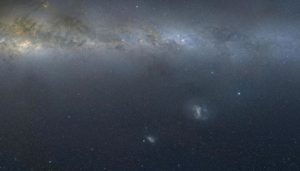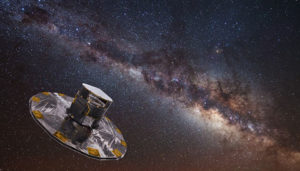The Milky Way's two largest companion galaxies may have once been a threesome — but new data from the Gaia satellite leaves the satellites' history an open question.

Axel Mellinger, Central Michigan Univ.
The Magellanic Clouds — the two largest galaxies orbiting the Milky Way — are a familiar sight to anyone in the Southern Hemisphere. Now, astronomers from Australia suggest that this famous duo might have once been a threesome.
A collision between the Large Magellanic Cloud (LMC) and a third partner explains a herd of stars allegedly orbiting in the opposite direction from the rest of the galaxy, Benjamin Armstrong and Kenji Bekki (University of Western Australia) argue in their study, which appears in the October 11 Monthly Notices of the Royal Astronomical Society.
But data from the European Space Agency’s Gaia spacecraft, which is on a five-year mission to chart the positions and speeds of over a billion stars in and around the Milky Way, may have already put a damper on the idea of a Magellanic triplet.
A Galactic Trio?
Until now, the prevailing story was that the LMC had stripped these deviant stars from the Small Magellanic Cloud (SMC) during a close encounter. “It makes sense, these two galaxies interact all the time,” says Armstrong. Plus, the abundance of heavy elements in these stars is similar to other stars in the SMC. “But a few key facts didn’t quite add up.”
A pack of stars moving counter to other stars in the LMC requires the SMC to whip around in the opposite direction as its rotation. But all other traces of previous run-ins, such as a tenuous bridge of gas linking the two galaxies, imply the opposite: the SMC must have turned in the same direction as its rotation.
“We thought, maybe these [stars] came from another galaxy entirely,” says Armstrong. “To our great relief, [that scenario] worked quite well.”
He and Bekki ran computer simulations in which the LMC collided with a smaller dwarf galaxy 3 billion to 5 billion years ago. The outcome was a simulated LMC that looks very much like the real one does today, with a small population of stars moving against the others.
“The idea that the LMC and SMC have had more than companion and potential interactions with other small galaxies is plausible and probably likely,” says Knut Olsen (National Optical Astronomy Observatory), who coauthored the 2011 paper reporting on these oddball stars. He points out that several of the dwarf galaxies that have been discovered in the past few years orbiting the Milky Way might actually be satellites of the Magellanic Clouds.
Still an Open Question

ESA / ATG medialab; background: ESO / S. Brunier
However, a cannibalized companion might not be needed after all. Olsen has been looking at data on these stars from the Gaia spacecraft. “There’s no evidence that they’re counter-rotating,” he says.
There has always been debate about the stars’ true motions. The original data measured only the component of the stars’ velocities that pointed toward or away from Earth, which left some ambiguity in their 3D motion. Gaia adds another dimension by tracking movement across the sky. And those data reveal that the stars are actually orbiting in the same direction as the LMC but on a highly inclined plane.
That doesn’t deter Armstrong. “While it's obviously not ideal for our theory,” he says, “it raises some fascinating questions about how these high-inclination stars came to be rotating as such.”
Indeed, astronomers don’t fully understand this stellar population. “There haven’t been any models that can explain it,” Olsen says. The closest, he says, is a scenario proposed in 2013 by astronomer Gurtina Besla and colleagues in which the Magellanic Clouds suffered a head-on collision roughly 200 million years ago.
However, a third Magellanic Cloud, while potentially not needed, is something worth considering, Olsen says. “It’s this kind of work and imaginative thinking that helps advance the progress of science.”
Armstrong is equally hopeful. “Even if our theory doesn't end up being applicable to the LMC,” he says, “our model should still . . . help us understand galaxy evolution as a whole.” And the LMC will continue to be a prominent laboratory for bettering that understanding. Its proximity gives researchers an unmatched look at how galaxies play off each other. “By understanding the finer details of how galaxies interact and form bigger galaxies,” says Armstrong, “we get a much clearer picture of how the universe is at it is.”
 0
0









Comments
You must be logged in to post a comment.